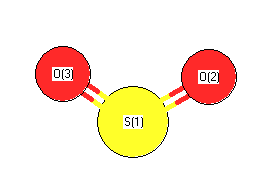Vibrational Frequencies calculated at B2PLYP=FULL/6-311+G(3df,2p)
| Mode Number |
Symmetry |
Frequency
(cm-1) |
Scaled Frequency
(cm-1) |
IR Intensities
(km mol-1) |
Raman Act
(Å4/u) |
Dep P |
Dep U |
|---|
| 1 |
A1 |
1140 |
1140 |
23.39 |
35.62 |
0.15 |
0.26 |
| 2 |
A1 |
511 |
511 |
26.91 |
2.66 |
0.60 |
0.75 |
| 3 |
B2 |
1349 |
1349 |
185.74 |
10.97 |
0.75 |
0.86 |
Unscaled Zero Point Vibrational Energy (zpe) 1499.8 cm
-1
Scaled (by 1) Zero Point Vibrational Energy (zpe) 1499.8 cm
-1
See section
III.C.1 List or set vibrational scaling factors
to change the scale factors used here.
See section
III.C.2
Calculate a vibrational scaling factor for a given set of molecules
to determine the least squares best scaling factor.
